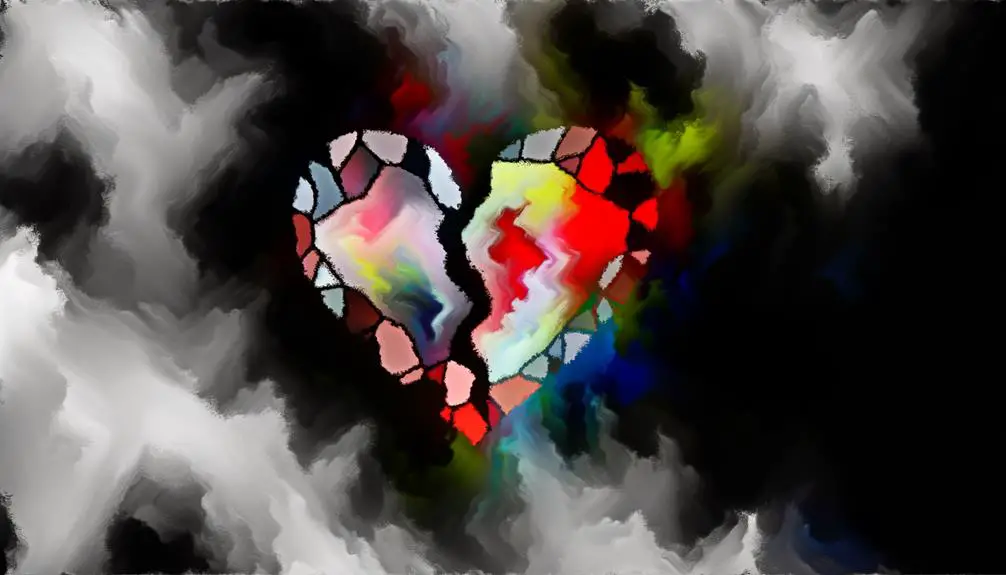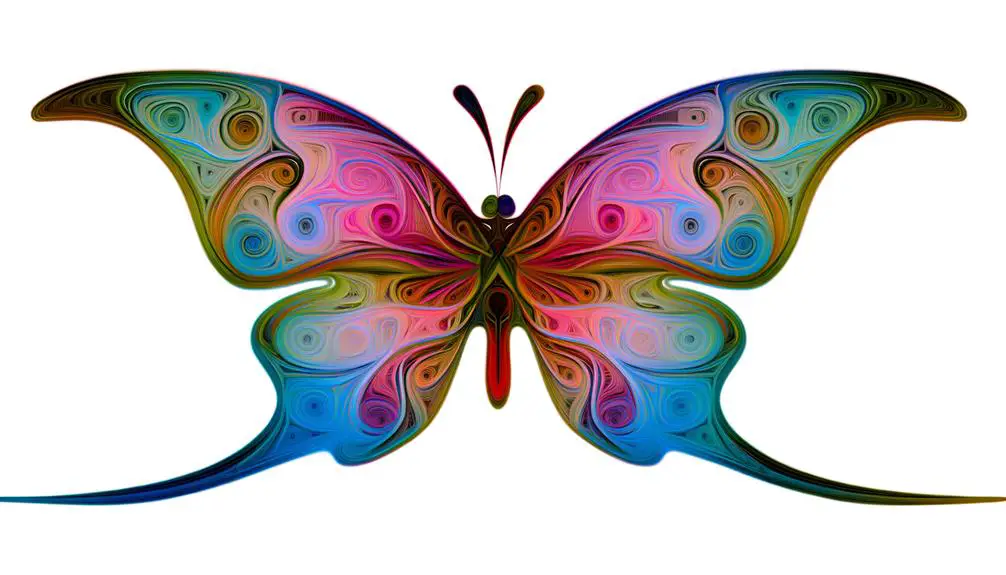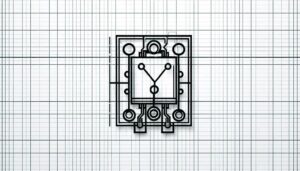Symbols Representing Borderline Personality Disorder
A symbol for Borderline Personality Disorder (BPD) plays a significant role in raising awareness, reducing stigma, and fostering community support. Current symbols, such as butterflies, semicolons, and puzzle pieces, attempt to capture the complex emotional and identity struggles associated with BPD.
Effective symbols should incorporate elements like emotional intensity and relational dynamics, perhaps using motifs such as broken hearts or lotus flowers. Community feedback is essential in creating a resonant, inclusive symbol that enhances public empathy and understanding.
Advocacy groups and professionals are pivotal in driving this initiative to adoption. To grasp the broader implications, further discussion is warranted.

Key Takeaways
- A recognized symbol for BPD can facilitate awareness and reduce stigma surrounding the disorder.
- Symbols like broken hearts, lotus flowers, and contrasting colors are potential designs for representing BPD.
- Community input is crucial in creating a meaningful and resonant symbol for BPD.
- Advocacy groups and mental health professionals play a vital role in promoting and adopting a BPD symbol.
- A well-crafted symbol can increase public empathy and support for individuals with BPD.
Importance of a Symbol
A symbol for Borderline Personality Disorder (BPD) holds significant importance as it can facilitate awareness, reduce stigma, and foster a sense of community among those affected by the disorder.
Research indicates that visual symbols can effectively convey complex concepts and foster recognition. For BPD, a well-recognized symbol can serve as a visual shorthand, promoting public education and understanding.
Additionally, it can help destigmatize the disorder by normalizing its discussion within broader society. The presence of a unifying symbol can also provide individuals with BPD a sense of belonging and validation, which is pivotal for their mental well-being.
Empirical evidence suggests that community and social support are pivotal in managing BPD symptoms, thereby underscoring the symbol's potential positive impact.
Historical Context of Mental Health Symbols
Throughout history, symbols have played an essential role in shaping public perceptions and understanding of mental health conditions. Ancient civilizations often used symbolic representations, such as the caduceus, to signify healing and well-being.
In more recent times, the green ribbon has emerged as a universal symbol for mental health awareness, promoting solidarity and reducing stigma. These symbols serve not only as visual shorthand but also as tools for advocacy and education.
Scholarly research indicates that effective symbols can foster empathy and promote a more nuanced understanding of mental health disorders. However, the challenge remains to create symbols that encapsulate the complexity of conditions like Borderline Personality Disorder (BPD), ensuring they are both inclusive and representative.
Current Symbols for BPD

Current symbols for Borderline Personality Disorder (BPD) are notably less standardized compared to those for other mental health conditions, reflecting the ongoing challenges in achieving a unified representation for this complex disorder. This lack of standardization can be attributed to the multifaceted nature of BPD, which includes emotional instability, intense interpersonal relationships, and identity disturbances.
Despite these challenges, several symbols have emerged within various communities:
- Butterflies: Representing transformation and the potential for growth, often used in advocacy and support groups.
- Semicolons: Symbolizing continuation and resilience, widely recognized in mental health awareness.
- Puzzle pieces: Denoting complexity and the need for understanding the various aspects of BPD.
These symbols aim to foster awareness and promote solidarity among those affected by BPD.
Potential Designs and Meanings
Given the diverse and multifaceted nature of Borderline Personality Disorder, potential designs for a unifying symbol must carefully consider elements that encapsulate the emotional intensity, relational dynamics, and identity struggles characteristic of the condition.
A broken heart might symbolize emotional volatility, while a puzzle piece could represent the complex and fragmented sense of self.
The lotus flower, known for its growth in muddy waters, could signify resilience amidst adversity.
Additionally, the use of contrasting colors, such as black and white, might illustrate the dichotomous thinking often associated with BPD.
These design elements aim to foster awareness and empathy, offering a visual representation that resonates with both individuals affected by BPD and the broader community.
Community Input and Feedback
Community input and feedback are essential in shaping a symbol that authentically represents Borderline Personality Disorder (BPD). By gathering experiences and insights, we can guarantee that the symbol resonates with those affected and incorporates meaningful design suggestions.
This collective voice is vital for creating a symbol that fosters understanding and unity within the BPD community.
Experiences and Insights Shared
Numerous individuals with Borderline Personality Disorder (BPD) have shared their experiences and insights, providing valuable community input and feedback that underscores both the challenges and coping mechanisms associated with the disorder.
These personal accounts offer a deeper understanding of the lived reality of BPD, highlighting the complexity and diversity of experiences.
Three key themes have emerged from community feedback:
- Emotional Intensity: Many individuals report experiencing intense emotions that can be overwhelming and difficult to manage.
- Interpersonal Relationships: Struggles with maintaining stable relationships due to fear of abandonment and fluctuating self-image are commonly noted.
- Coping Strategies: Effective coping mechanisms such as mindfulness, therapy, and support groups have been identified as essential for managing symptoms.
Such insights are instrumental in shaping a thorough understanding of BPD.
Symbol Design Suggestions
Building on the shared experiences and insights, the community has also contributed a variety of symbol design suggestions that aim to visually represent the essence of Borderline Personality Disorder (BPD). Common themes include elements that signify duality, such as yin-yang symbols, to reflect the emotional instability characteristic of BPD.
Another popular design incorporates broken or fragmented hearts, symbolizing the intense interpersonal relationships often experienced. Some suggestions emphasize the use of colors, like black and white, to denote extremes in mood and perception.
Additionally, abstract designs featuring interconnected lines or spirals have been proposed to illustrate the complexity and layered nature of the disorder. These diverse inputs highlight the community's commitment to creating a meaningful and representative symbol for BPD.
Collective Voice Importance
The collective voice of individuals with Borderline Personality Disorder (BPD) is essential in guaranteeing that symbol designs are both meaningful and accurately representative of their lived experiences. Engaging the community in the design process can lead to symbols that foster a sense of ownership and validation. Evidence suggests that participatory design approaches contribute to higher acceptance and effectiveness of mental health symbols.
To effectively incorporate community input, consider the following:
- Surveys and Polls: Collect broad feedback on initial design ideas.
- Focus Groups: Engage smaller groups for in-depth discussions and iterative feedback.
- Online Forums: Utilize platforms where individuals with BPD can share insights and preferences.
Incorporating these methods guarantees the final symbol resonates with those it aims to represent.
Impact on Stigma Reduction
Adopting a symbol for Borderline Personality Disorder (BPD) could play a pivotal role in mitigating the stigma associated with the condition. Symbols have been shown to foster awareness and empathy, as seen with the success of symbols for other mental health conditions like the semicolon for suicide prevention.
The visual representation can normalize discussions around BPD, reducing misconceptions and prejudices. Research supports that increased visibility and education can diminish societal stigma (Corrigan, 2004).
Moreover, a symbol could empower those with BPD, promoting self-advocacy and community solidarity. By providing a focal point for awareness campaigns, a symbol has the potential to shift public perception, making BPD more comprehensible and accepted within societal discourse.
Future of the BPD Symbol
Looking ahead, the future of a symbol for Borderline Personality Disorder rests on the collective efforts of advocacy groups, mental health professionals, and individuals with BPD to establish a universally recognized emblem that resonates with both the public and those affected by the disorder. This initiative is pivotal for fostering awareness, reducing stigma, and promoting understanding.
Empirical evidence suggests that successful symbol adoption involves several key factors:
- Inclusivity: Ensuring that the symbol reflects the diverse experiences of those with BPD.
- Visibility: Amplifying the symbol through media, educational campaigns, and public endorsements.
- Consistency: Maintaining uniformity in the symbol's design and use to prevent confusion.
Ultimately, a well-crafted symbol could greatly enhance public empathy and support for individuals with BPD.
Conclusion
To wrap up, the establishment of a symbol for borderline personality disorder (BPD) holds considerable potential for reducing stigma and enhancing public awareness.
Historical and contemporary symbol usage in mental health shows the importance of visual representation in promoting understanding and empathy.
While some may argue that a symbol oversimplifies a complex condition, evidence indicates that effective symbolism can capture multifaceted issues and enable broader societal engagement.
As a result, creating a BPD symbol is a vital step towards greater mental health advocacy.






